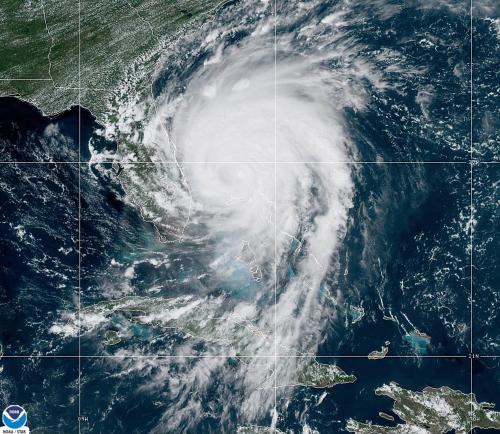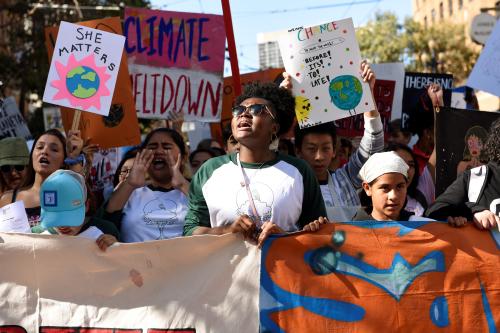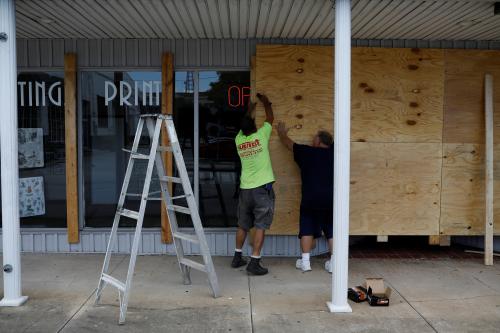These remarks were originally given by Elizabeth Ferris on February 28, 2012 at a workshop for staff of World Vision on natural disasters in urban areas.
Thanks for the opportunity to participate in today’s discussions with World Vision staff on Post-Disaster Urban Recovery. I want to begin by noting a few general trends and then focus my remarks on the intersection between violence and disasters and the implications of this for urban disaster recovery.
- We live in an urban world. Over half of the world’s population now lives in urban areas – a percentage that is expected to increase in the coming years. As more people live in cities, more urban residents will be affected by natural hazards. Moreover, the frequency and severity of natural disasters is increasing.
- Not only will more people live in cities, but they will live in areas more prone to natural hazards. Globally two-thirds of the world’s cities with populations over five million are at least partially located in coastal zones[1] – areas susceptible to coastal flooding and to the effects of climate change-induced sea level rise. Poorer people moving into cities are also likely to live in poor neighborhoods located on marginal land in urban areas. Currently, more than 1 billion persons, or about 14 percent of the world’s population live in slums – a figure which is also likely to increase.[2]
- Although a lot of attention is focused on the world’s megacities, in fact only 4 percent of the world’s population currently lives in megacities and most of the world’s urban growth is expected in cities with populations now under 5 million.
These trends have consequences for humanitarian actors who have developed more expertise at responding to emergencies in rural areas. In some respects working in cities is easier than working in rural areas. Communications and transportation are generally more developed in urban than in rural areas. The physical concentration of populations is greater so the logistics of delivery of assistance are often easier. Services and human resources are usually available. For example, while a hospital may suffer damage in a disaster, most cities have hospitals and trained medical staff. Because of the concentration of both media and political power in cities, there is also more attention and generally more political will to address communities affected by natural hazards in urban than in rural areas.
But at the same time, as experience in Haiti has taught us, an urban environment is often more complex than a rural one and brings its own set of challenges. In particular it is more difficult to identify beneficiaries within a large urban needy population. Directing efforts toward displaced persons, for example, may lead people to move to displacement sites in order to receive assistance. Questions around shelter/housing are as much about legal tenure and preventing evictions as about architectural design and construction. Responsibly working in longer-term recovery and reconstruction means working within an overall urban planning framework which itself may be weak or subject to intense political pressures. Finally, issues around the always-difficult boundary between humanitarian and development action are more complicated in urban areas – an issue I’ll return to later.
What does this mean for humanitarian actors, such as World Vision, responding to natural disasters in urban settings?
A need to develop new expertise, policies, and relationships. In order to respond effectively to humanitarian needs for shelter, legal expertise is needed to advise on how to deal with sticky issues of land tenure, the rights of renters and squatters to housing, and evictions. In order to develop responsible recovery/reconstruction plans, expertise in urban planning is needed. Providing technical advice to governments on basic issues of urban planning such as waste disposal systems or disaster risk reduction may be as beneficial (or more beneficial) to recovery efforts than construction of 100 or 1000 homes.
In addition to technical expertise, I think it would be helpful for humanitarian organizations to think through some of the difficult issues and decide in advance how their organizations will respond to questions such as: what will our role be in providing essential services that the state should provide but is unable to do so as the result of a natural hazard? Trucking in water may be accepted humanitarian work, but what about rebuilding a neighborhood’s sewer system? What will be the organization’s policy on working with the urban poor who may not have been directly affected by the natural disaster? For example, will health services be available to all in need? What will the organization’s role be in providing individual legal assistance on housing, land and property issues? In working for reform of land tenure systems that complicate recovery areas? These are difficult issues and it would be helpful for organizations to think through them before a natural disaster occurs. As advocates of international disaster relief law[3] (IDRL) emphasize, the chaos of the immediate aftermath of a disaster is not the best time to be thinking about far-reaching policies. Of course, different contexts require different and flexible responses, but it is likely that many of these issues will surface in more than one disaster.
Humanitarian organizations have traditionally worked in partnership with a range of other actors and have sought to strengthen humanitarian coordination in different ways. While these partnerships and coordination mechanisms are far from perfect, working in urban areas may mean a need for new and different kinds of partnerships. At least in some rural areas, it is possible to work with traditional leaders to identify vulnerable groups or to consult on programs. In urban areas, this may not be possible in part because of the mobility of urban populations. A religious leader in a slum, for example, may not have a handle on who are the most vulnerable members of a community. Humanitarian organizations will likely need to work with different levels of governmental authority, but also with a broader range of civil society organizations. Maybe a humanitarian organization doesn’t need to hire a team of lawyers to help in land tenure questions but can partner with a lawyers’ association or university law school to provide assistance.
Download the full remarks here.
[1] The Government Office for Science (London), Foresight: Migration and Global Environmental Change, Final Project Report, 2011.
[2] UN Habitat, State of the World’s Cities 2006/07, 2006, p. 5. Note that UN Habitat defines a slum household “as a group of individuals living under the same roof in an urban area who lack one or more of the following conditions: durable housing, sufficient living area, access to improved water and to sanitation, and secure tenure.” p. 21.
[3] See for example: IFRC, Guidelines for the Domestic Facilitation and Regulation of International Disaster Relief and Initial Recovery Assistance, 2007 (30IC/07/R4 annex), available at: www.ifrc.org.



Commentary
Urban Disasters, Conflict and Violence: Implications for Humanitarian Work
February 28, 2012